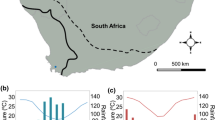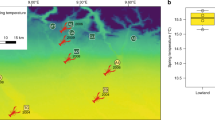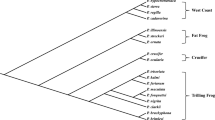Abstract
Species adjust their behavior and life-history to adapt to local environmental conditions. Species with a broad ecological niche often show signatures of local adaptations to different environment, particularly in extreme ones. Here, we investigate local adaptation in different populations of the North African Sahara frog (Pelophylax saharicus) living in various environmental conditions that vary mostly in temperature, precipitation, and elevation by mean of common garden experiment aiming to estimate the growth rate under two predation treatments (absence or presence of non-lethal cues of dragonfly larvae). First, we found an elevational cline in the reproductive phenology where, from low to high elevation, the reproductive season shifts to later dates, whereas that in arid environment was later than all other populations. We suggest that geographic differences in temperature and rainfall (in arid areas) explain this phenological pattern. Second, hatching success was overall high but showed a slight decline across elevation. Third, growth rate was generally faster in low and intermediate elevation populations, but slower in high elevation and arid environment populations. Populations in low and intermediate elevation responded to predation by reducing growth rate and the size at metamorphosis, but no predatory responses were recorded in high elevation and arid environment populations. Our study shows some life history signatures of local adaptation of P. saharicus in Northeast Algeria, which does not go in line with recent genetic analysis showing low population differentiation in the region.







Similar content being viewed by others
Data availability
The datasets used and/or analyzed during the current study are available from the corresponding author on reasonable request.
References
Altwegg R, Reyer HU (2003) Patterns of natural selection on size at metamorphosis in water frogs. Evolution 57:872–882. https://doi.org/10.1111/j.0014-3820.2003.tb00298.x
Amor N, Farjallah S, Said K (2009) Morphometric variation in the Tunisian green frog, Rana saharica Anura: Ranidae. Afr Zool 44:194–203. https://doi.org/10.3377/004.044.0207
Amor N, Farjallah S, Benyacoub S, Merella P, Said K (2010) Karyological and morphometric variation of the North African green frog Pelophylax saharicus (Anura) in north-eastern Africa. Curr Zool 56:678–686. https://doi.org/10.1093/czoolo/56.6.678
Amor N, Velo-Antón G, Farjallah S, Said K (2010) Genetic variation across Tunisian populations of the anuran species Discoglossus pictus and Pelophylax saharicus Afr Zool 45:121–128. https://doi.org/10.3377/004.045.0108
Ashton KG (2002) Do amphibians follow Bergmann’s rule? Can J Zool 80:708–716. https://doi.org/10.1139/z02-049
Ashton KG (2004) Sensitivity of intraspecific latitudinal clines of body size for tetrapods to sampling, latitude and body size. Integr Comp Biol 44:403–412. https://doi.org/10.1093/icb/44.6.403
Babbitt K (2001) Behaviour and growth of southern leopard frog (Rana sphenocephala) tadpoles: effects of food and predation risk. Can J Zool 79:809–814. https://doi.org/10.1139/z01-040
Bellakhal M, Neveu A, Fartouna-Bellakhal M, Missaoui H, Aleya L (2014) Effects of temperature, density and food quality on larval growth and metamorphosis in the north African green frog Pelophylax saharicus. J Therm Biol 45:81–86. https://doi.org/10.1016/j.jtherbio.2014.08.006
Bellakhal M, Neveu A, Fertouna-Bellakhal M, Aleya L (2017) Artificial wetlands as tools for frog conservation: stability and variability of reproduction characteristics in Sahara frog populations in Tunisian man-made lakes. Environ Sci Pollut Res 24:26658–26669. https://doi.org/10.1007/s11356-017-0278-6
Benard MF (2004) Predator-induced phenotypic plasticity in organisms with complex life histories. Annu Rev Ecol Evol Syst 35:651–673. https://doi.org/10.1146/annurev.ecolsys.35.021004.112426
Berrill M, Bertram S, McGilliray L, Kolohon M, Pauli B (1994) Effects of low concentrations of forest-use pesticides on frog embryos and tadpoles. Environ Toxicol Chem 13:657–664. https://doi.org/10.1002/etc.5620130416
Bertness MD, Garrity SD, Levings SC (1981) Predation pressure and gastropod foraging: A tropical-temperate comparison. Evolution 35:995–1007. https://doi.org/10.1111/j.1558-5646.1981.tb04965.x
Berven KA, Gill DE (1983) Interpreting geographic variation in life-history traits. Am Zool 23:85–97
Blackburn TM, Gaston KJ, Loder N (1999) Geographic gradients in body size: a clarification of Bergmann’s rule. Divers Distrib 5:165–174. https://doi.org/10.1046/j.1472-4642.1999.00046.x
Blanckenhorn W, Demont M (2004) Bergmann and converse Bergmann latitudinal clines in arthropods: two ends of a continuum? Integr Comp Biol 44:413–424. https://doi.org/10.1093/icb/44.6.413
Blumthaler M, Ambach W, Ellinger R (1997) Increase in solar UV radiation with altitude. J Photochem Photobiol B Biol 39:130–134. https://doi.org/10.1016/S1011-1344(96)00018-8
Bolser RC, Hay ME (1996) Are tropical plants better defended? Palatability and defenses of temperate vs. tropical seaweeds. Ecology 77:2269–2286. https://doi.org/10.2307/2265730
Brenner FJ (1969) The role of temperature and fat deposition in hibernation and reproduction in two species of frogs. Herpetologica 25:105–113
Christian KA (1982) Changes in the food niche during postmetamorphic ontogeny of the frog Pseudacris triseriata. Copeia 1982:73–80. https://doi.org/10.2307/1444270
Conover DO, Schultz ET (1995) Phenotypic similarity and the evolutionary significance of countergradient variation. Trends Ecol Evol 10:248–252. https://doi.org/10.1016/S0169-5347(00)89081-3
Cook SA, Johnson MP (1968) Adaptation to heterogeneous environments. I. Variation in heterophylly in Ranunculus flammula L. Evolution 22:496–516. https://doi.org/10.1111/j.1558-5646.1968.tb03988.x
Duellman WE, Trueb L (1994) Biology of amphibians. JHU Press, New York, McGraw-Hill
Funk WC, Blouin MS, Corn PS, Maxell BA, Pilliod DS, Amish S et al (2005) Population structure of Columbia spotted frogs (Rana luteiventris) is strongly affected by the landscape. Mol Ecol 14:483–496. https://doi.org/10.1111/j.1365-294X.2005.02426.x
Hassine B, Nouira S (2009) Diet of Discoglossus pictus Otth 1837 (Anura, Alytidae) and Pelophylax saharicus (Boulenger in Hartert, 1913) in the oases of Kettana (Gabes, Tunisia). Bull Soc Zool Fr 134:321–332
Hemelaar A (1988) Age, growth and other population characteristics of Bufo bufo from different latitudes and altitudes. J Herpetol 22:369–388. https://doi.org/10.2307/1564332
Highton R (1962) Geographic variation in the life history of the slimy salamander. Copeia 1962:597–613. https://doi.org/10.2307/1441185
Howard JH, Wallace RL (1985) Life history characteristics of populations of the long-toed salamander (Ambystoma macrodactylum) from different altitudes. Am Midl Nat 113:361–373. https://doi.org/10.2307/2425582
Jakob C, Poizat G, Veith M, Seitz A, Crivelli AJ (2003) Breeding phenology and larval distribution of amphibians in a Mediterranean pond network with unpredictable hydrology. Hydrobiologia 499:51–61. https://doi.org/10.1023/A:1026343618150
Klaus SP, Lougheed SC (2013) Changes in breeding phenology of eastern Ontario frogs over four decades. Ecol Evol 3:835–845. https://doi.org/10.1002/ece3.501
Klopfer PH, MacArthur RH (1960) Niche size and faunal diversity. Am Nat 94:293–300. https://doi.org/10.1086/282130
Kobelt F, Linsenmair K (1995) Adaptations of the reed frog Hyperolius viridiflavus (Amphibia, Anura, Hyperoliidae) to its arid environment. VII. The heat budget of Hyperolius viridiflavus nitidulus and the evolution of an optimized body shape. J Comp Physiol B 165:110–124. https://doi.org/10.1007/BF00301475
Laugen AT, Laurila A, Jönsson KI, Söderman F, Merilä J (2005) Do common frogs (Rana temporaria) follow Bergmann’s rule? Evol Ecol Res 7:717–731
Laurila A, Lindgren B, Laugen AT (2008) Antipredator defenses along a latitudinal gradient in Rana temporaria Ecology 89:1399–1413. https://doi.org/10.1890/07-1521.1
Licht LE (1975) Comparative life history features of the western spotted frog, Rana pretiosa, from low-and high-elevation populations. Can J Zool 53:1254–1257. https://doi.org/10.1139/z75-150
Ma X, Lu X, Merilä J (2009) Altitudinal decline of body size in a Tibetan frog. J Zool 279:364–371. https://doi.org/10.1111/j.1469-7998.2009.00627.x
Meddeb C, Nouira S, Cheniti TL, Walsh PT, Downie J (2007) Age structure and growth in two Tunisian populations of green water frogs Rana saharica: a skeletochronological approach. Herpetol J 17:54–57
Moran NA (1992) The evolutionary maintenance of alternative phenotypes. Am Nat 139:971–989
Morrison C, Hero JM (2003) Geographic variation in life-history characteristics of amphibians: a review. J Anim Ecol 72:270–279. https://doi.org/10.1046/j.1365-2656.2003.00696.x
Nevo E (1973) Adaptive variation in size of cricket frogs. Ecology 54:1271–1281. https://doi.org/10.2307/1934189
Nicolas V, Mataame A, Crochet PA, Geniez P, Ohler A (2015) Phylogeographic patterns in north African water frog Pelophylax saharicus (Anura: Ranidae). J Zool Syst Evol Res 53:239–248. https://doi.org/10.1111/jzs.12094
Nylin S, Gotthard K (1998) Plasticity in life-history traits. Annu Rev Entomol 43:63–83. https://doi.org/10.1146/annurev.ento.43.1.63
Orizaola G, Dahl E, Nicieza AG, Laurila A (2013) Larval life history and anti-predator strategies are affected by breeding phenology in an amphibian. Oecologia 171:873–881. https://doi.org/10.1007/s00442-012-2456-z
Oromi N, Brunet P, Taibi K, Aït Hammou M, Sanuy D (2011) Life-history traits in Pelophylax saharicus from Tiaret semiarid lands (northwestern Algeria). Herpetol J 21:267–269
Ovaska K, Davis TM, Flamarique IN (1997) Hatching success and larval survival of the frogs Hyla regilla and Rana aurora under ambient and artificially enhanced solar ultraviolet radiation. Can J Zool 75:1081–1088. https://doi.org/10.1139/z97-130
Palmer AR (1979) Fish predation and the evolution of gastropod shell sculpture: experimental and geographic evidence. Evolution 33:697–713. https://doi.org/10.2307/2407792
Parmesan C (2007) Influences of species, latitudes and methodologies on estimates of phenological response to global warming. Glob Change Biol 13:1860–1872. https://doi.org/10.1111/j.1365-2486.2007.01404.x
Pettus D, Angleton GM (1967) Comparative reproductive biology of montane and piedmont chorus frogs. Evolution 21:500–507. https://doi.org/10.2307/2406611
Primack RB, Ibáñez I, Higuchi H, Lee SD, Miller-Rushing AJ, Wilson AM et al (2009) Spatial and interspecific variability in phenological responses to warming temperatures. Biol Conserv 142:2569–2577. https://doi.org/10.1016/j.biocon.2009.06.003
R Development Core Team (2019) R: A language and environment for statistical computing. R Foundation for Statistical Computing, Vienna
Relyea RA (2001) Morphological and behavioral plasticity of larval anurans in response to different predators. Ecology 82:523–540. https://doi.org/10.1890/0012-9658(2001)082[0523:MABPOL]2.0.CO;2
Relyea RA (2002) The many faces of predation: how induction, selection, and thinning combine to alter prey phenotypes. Ecology 83:1953–1964. https://doi.org/10.1890/00129658(2002)083[1953:TMFOPH]2.0.CO;2
Riis N (1991) A field study of survival, growth, biomass and temperature dependence of Rana dalmatina and Rana temporaria larvae. Amphibia-Reptilia 12:229–243. https://doi.org/10.1163/156853891X00419
Ryser J (1996) Comparative life histories of a low-and a high-elevation population of the common frog Rana temporaria Amphibia-Reptilia 17:183–195. https://doi.org/10.1163/156853896X00379
Santini L, Benítez-López A, Ficetola GF, Huijbregts MA (2018) Length–mass allometries in amphibians. Integr Zool 13:36–45. https://doi.org/10.1111/1749-4877.12268
Sartorius SS, Rosen PC (2000) Breeding phenology of the lowland leopard frog (Rana yavapaiensis): implications for conservation and ecology. Southwest Nat 45:267–273. https://doi.org/10.2307/3672829
Schleich HH, Kästle W, Kabisch K (1996) Amphibians and reptiles of North Africa. Koeltz Scientific Books, Koenigstein
Schmidt-Nielsen K (1997) Animal physiology: adaptation and environment. Cambridge University Press, Cambridge
Scholz F, Zhu A (2016) kSamples: K-sample rank tests and their combinations. R package version 1:2–3
Skelly DK (2004) Microgeographic countergradient variation in the wood frog, Rana sylvatica. Evolution 58:160–165. https://doi.org/10.1554/03-425
Tong Q, Du X-p, Hu Z-f, Cui L-y, Wang H-b (2018) Modelling the growth of the brown frog (Rana dybowskii). PeerJ 6:e4587. https://doi.org/10.7717/peerj.4587
Valladares F, Balaguer L, Martinez-Ferri E, Perez‐Corona E, Manrique E (2002) Plasticity, instability and canalization: is the phenotypic variation in seedlings of sclerophyll oaks consistent with the environmental unpredictability of Mediterranean. ecosystems? New Phytol 156:457–467. https://doi.org/10.1046/j.1469-8137.2002.00525.x
Van Buskirk J (2000) The costs of an inducible defense in anuran larvae. Ecology 81:2813–2821. https://doi.org/10.1890/0012-9658(2000)081[2813:TCOAID]2.0.CO;2
Van Buskirk J (2002) A comparative test of the adaptive plasticity hypothesis: relationships between habitat and phenotype in anuran larvae. Am Nat 160:87–102
Werner EE (1986) Amphibian metamorphosis: growth rate, predation risk, and the optimal size at transformation. Am Nat 128:319–341
Acknowledgements
We are thankful to anonymous reviewers for their constructive comments and suggestions. We are indebted to the lab technician Leila and all students who helped in the experiment. This study is supported by the Algerian ministry of high education and scientific research.
Author information
Authors and Affiliations
Contributions
All authors contributed to the study conception and design. Material preparation and data collection were performed by Zinette Bensakhri, Soufyane Bensouilah, Abdeldjalil Youcefi, Hichem Amari, Abdelheq Zouaimia and Amel Lazli. Data analysis was performed by Rabah Zebsa and Rassim Khelifa. The first draft of the manuscript was written by Zinette Bensakhri, Soufyane Bensouilah and Moussa Houhamdi, and all authors commented on previous versions of the manuscript. All authors read and approved the final manuscript.
Corresponding author
Ethics declarations
Conflict of interest
The authors declare no conflicts of interest.
Ethics approval
Not applicable.
Additional information
Publisher’s note
Springer Nature remains neutral with regard to jurisdictional claims in published maps and institutional affiliations.
Supplementary Information
Below is the link to the electronic supplementary material.
ESM 1
(PDF 461 KB)
Rights and permissions
About this article
Cite this article
Bensakhri, Z., Bensouilah, S., Zebsa, R. et al. Trends to adaptation of the Sahara frog (Pelophylax saharicus) larvae across an environmental gradient. Biologia 77, 2857–2866 (2022). https://doi.org/10.1007/s11756-022-01151-2
Received:
Accepted:
Published:
Issue Date:
DOI: https://doi.org/10.1007/s11756-022-01151-2




